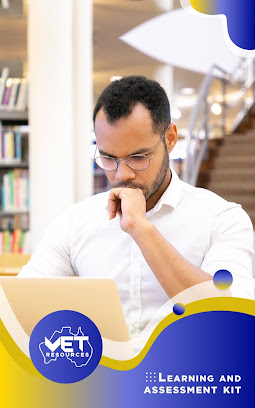Smart Ways to Source Quality RTO Training Materials for Your Organisation
Running a successful Registered Training Organisation (RTO) requires much more than qualified trainers or compliant systems — it demands high-quality RTO training materials that genuinely help learners achieve competency outcomes. The Australian VET (Vocational Education and Training) sector thrives on quality, and the training resources you choose can either enhance or hinder your reputation. But with hundreds of suppliers and packages available online, how do you ensure your RTO gets the best value and remains compliant with national standards?
This comprehensive guide explores smart sourcing strategies for RTO training materials, how to identify reliable suppliers, why contextualisation matters, and what supporting tools (like LLND and RPL kits) can make your assessment process more efficient.
Why Quality RTO Training Materials Are the Backbone of Every RTO
RTOs operate in a highly regulated environment, and your training resources play a major role in maintaining compliance with ASQA (Australian Skills Quality Authority) requirements. Poor-quality materials can trigger audit issues, learner dissatisfaction, and even loss of accreditation.
When sourcing shop RTO training materials, ensure they align with the latest Training Package requirements, include assessor guides, mapping documents, and learner resources that are easy to contextualise. It’s also vital to check that the materials come from a trusted supplier who updates them regularly and provides continuous support.
💡 Pro Tip: Never choose based on price alone. The cheapest option may cost you more later if it leads to audit non-compliance or rework.
What Makes a Good RTO Resource Provider?
A good provider does more than just sell content. They become a compliance partner. Here’s what to look for when assessing RTO resource suppliers:
-
Comprehensive Mapping Documents – Ensure every unit of competency is properly mapped to performance and knowledge evidence.
-
Editable File Formats – Materials should be provided in Word or similar formats for easy contextualisation.
-
Assessment Benchmarks – The provider should include marking guides and assessor versions.
-
VET-Compliant Design – The resources must meet standards for fairness, flexibility, reliability, and validity.
-
Audit Support – Choose a supplier that provides after-sales assistance, especially during ASQA audits.
-
Regular Updates – Training packages evolve frequently. Ensure your supplier updates materials accordingly.
Many established suppliers offer free samples or demo access. Reviewing these before purchase ensures you understand the structure, layout, and usability of their resources.
⚙️ Quick Insight: Consistent formatting and language across all units make your RTO’s delivery smoother and more professional.
Contextualisation – The Hidden Secret to Learner Success
Contextualisation is a requirement under ASQA standards. It allows you to modify training materials to suit your learners’ workplace context, industry, and job roles — without changing the unit’s core elements.
For example, a unit on “Workplace Safety” can be tailored differently for a construction student compared to one in aged care. Good RTO resources are built with contextualisation flexibility in mind.
When evaluating resource providers, ask:
-
Can we easily edit the learner guides and assessments?
-
Are workplace examples provided?
-
Do materials include real-life case studies or generic ones?
💡 Pro Tip: Contextualised examples improve learner engagement and assessment accuracy. Always review this aspect before implementation.
Why Every RTO Should Invest in LLND Assessment Kits
Another crucial but often overlooked aspect of RTO operations is foundation skill assessment. Learners entering a course may have varying literacy, language, and numeracy levels — and assessing these upfront ensures they receive the right level of support.
That’s where LLND assessment kits become invaluable. These kits help you measure students’ core skill levels before they begin training, ensuring that learners are placed in the right programs or receive appropriate foundation skill support.
They are also a compliance requirement under ASQA’s Standards for RTOs, particularly Clauses 1.7 and 1.2, which demand evidence of learner suitability and support strategies.
A high-quality LLND kit should include:
-
Comprehensive reading, writing, and numeracy assessments
-
Clear marking and result interpretation guides
-
Benchmarks linked to the Australian Core Skills Framework (ACSF)
-
Templates for recording and reporting results
🧭 Pro Tip: Conduct LLND assessments during enrolment or induction. It not only ensures compliance but also improves student completion rates.
RPL Kits – Streamlining Recognition of Prior Learning
Recognition of Prior Learning (RPL) is an essential part of the VET system. It allows learners to receive credit for skills and knowledge they’ve already gained through previous work or study. However, designing valid and reliable RPL assessments from scratch can be challenging.
That’s why many RTOs opt for pre-validated RPL kit packages from trusted suppliers. These kits include ready-to-use RPL templates, evidence checklists, third-party verification forms, and assessor guides.
When chosen wisely, RPL kits can dramatically reduce assessment time while maintaining compliance. They also provide a structured framework for evidence collection, ensuring that recognition decisions are transparent and consistent.
💡 Pro Tip: RPL kits should not be generic — ensure they align precisely with the units of competency and job outcomes your RTO delivers.
How to Evaluate a Supplier Before Buying
Before you finalise a purchase, conduct a quick checklist:
-
Review Sample Units: Look for structure, clarity, and compliance alignment.
-
Ask About Licensing Terms: Ensure you have permission for internal use and contextualisation.
-
Check for Digital Compatibility: Are the files SCORM-compliant or LMS-ready?
-
Read Reviews or Case Studies: Other RTOs’ experiences can reveal a lot about reliability.
-
Assess Customer Support: Reliable post-purchase support matters during audit preparation.
⚙️ Smart Move: Build long-term relationships with suppliers that understand your RTO’s goals and training scope.
Blended Learning and Digital Readiness
Modern RTOs are rapidly adopting digital delivery methods, from LMS (Learning Management Systems) to eLearning modules. Hence, it’s important to choose training materials that are digital-friendly.
Look for suppliers who offer eLearning SCORM packages or digital assessments compatible with systems like Moodle or Canvas. These digital resources not only make learning accessible but also improve tracking, reporting, and learner engagement.
Moreover, blended learning approaches — combining online and classroom methods — enhance flexibility, especially for working learners.
🌐 Pro Tip: Always ensure your eLearning content is mobile-responsive and accessible to all learners, including those with disabilities.
Common Mistakes to Avoid When Sourcing RTO Resources
Even experienced RTOs can fall into traps when purchasing training materials. Here are some common pitfalls to avoid:
-
Buying outdated materials: Always confirm the version and release number.
-
Ignoring mapping documents: Missing or incorrect mapping can lead to audit issues.
-
Not verifying contextualisation options: Rigid materials limit adaptability.
-
Skipping compliance checks: Make sure the materials meet ASQA and training package rules.
-
Choosing unverified suppliers: Only buy from providers with a solid reputation and proven VET experience.
⚠️ Reminder: Auditors often ask for evidence that your training materials match the current training package. Keep version control records for every resource used.
How Good Resources Impact Learner Outcomes
High-quality materials don’t just satisfy compliance — they shape better learning experiences. When students understand content easily and assessments feel relevant, their motivation and completion rates rise significantly.
Moreover, trainers benefit too — clear marking guides and contextual examples make assessment more consistent and transparent. In the long run, investing in reliable RTO resources enhances your brand reputation and student trust.
🧩 Pro Tip: Continuous improvement is key — collect trainer and learner feedback after each unit to refine your resources over time.
Conclusion: Choosing the Right Partner for Long-Term Success
Your training resources define the quality and credibility of your RTO’s delivery. Whether you’re starting out or scaling operations, partnering with reliable suppliers who understand compliance, contextualisation, and learner engagement is crucial.
From sourcing the right shop RTO training materials to integrating LLND assessment kits and leveraging RPL kit resources, the key lies in thoughtful selection and consistent quality checks. With the right foundation, your RTO can not only meet compliance standards but also deliver impactful, industry-relevant education that truly benefits learners.
FAQs
1. What are RTO training materials?
RTO training materials are structured learning and assessment resources that support the delivery of nationally recognised qualifications under the VET framework.
2. Why should I buy RTO materials instead of creating my own?
Creating compliant, audit-ready materials takes time and expertise. Purchasing pre-developed ones from trusted providers saves resources while ensuring compliance.
3. How often should RTO resources be updated?
You should review and update them every time a training package is revised or when ASQA releases new compliance guidelines.
4. What’s included in a standard LLND assessment kit?
Typically, LLND kits include literacy, language, and numeracy tests, marking guides, ACSF level benchmarks, and templates for recording outcomes.
5. Can RPL kits be customised?
Yes. Most providers offer editable RPL kits that can be contextualised to your RTO’s training scope and learner cohort.
6. Where can I find compliant RTO resources?
Look for trusted providers that specialise in Australian VET training, such as those offering editable, audit-ready materials with support and regular updates.



Comments
Post a Comment